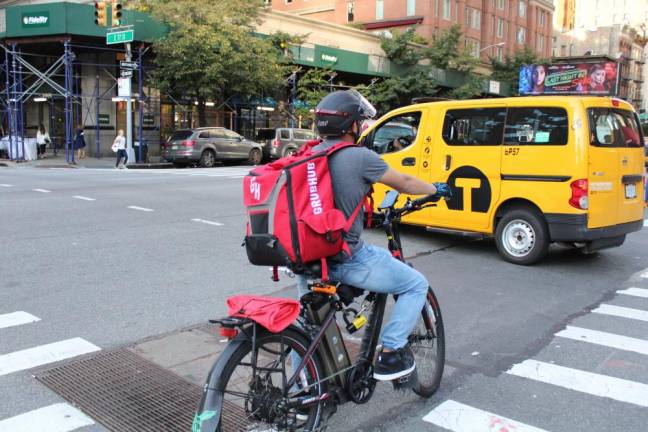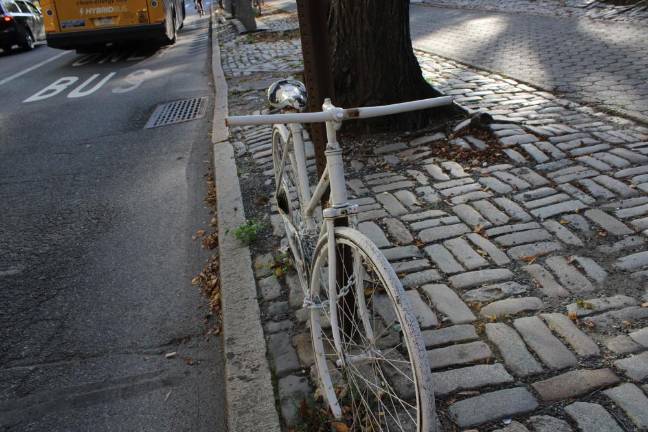In the first nine months of 2021, ten delivery cyclists have died. That is three more than all the delivery biker deaths from 2020, according to research done by the Worker’s Justice Project (WJP) and The Worker Institute of Cornell University’s ILR School. The report opens with the names of delivery bikers who have died so far in 2021: Juan Lucirgo Cruz, Francisco Villalva Vitinio, Luis Alvaro Hernandez, Xing Long Lin, Borkot Ullah, Federico Zaput Palax, Tarek Aziz, Jose Garcia Gomez and Noe Amador Licona. Now New Yorkers are asking what must be done to keep the streets safe.
The Department of Transportation’s (DOT) bicycle counts show increase in ridership during almost every month of the year both in 2020 and again in 2021. With that trend came benefits such as decreased CO2 emissions and a move towards more sustainable transportation. But with the increase in bikes came the increase in potential danger, largely for two reasons: 1) Along with the pandemic, New York saw an epidemic of speeding incidents as roads were empty. In the past year speeding has become the leading cause of injury or death in the streets. And 2) more people are buying SUVs, making it safer for drivers and passengers, while increasing the danger for pedestrians and cyclists.
Recreational cyclists seem unconcerned with the overall increase in injury. “You’re taking a risk especially because I don’t wear a helmet either,” says Joe Chang, who learned to bike through traffic during the pandemic. “I know it’s a big it’s a risk, but I think it’s worth it.”
Chang enjoys the freedom of being able to go anywhere in the city, especially when cars were off the roads during the pandemic. But now there are more obstacles. “You have to dodge pedestrians, other bikers, scooters now and cars,” he says. “Sometime during the pandemic, a truck driver yelled at me ‘Hey, don’t be number 19! Don’t be number 19!’” referring to the 18 bike deaths that had already taken place.
Another cyclist on the East Side, Nishant (who preferred not to give his last name), was less blasé. “The East Side’s not the safest because there’s only one northbound lane,” he says. “I know there’s a lot of traffic here; certain avenues could be better.”
Repeated Injuries
While fatalities are a major problem, injury is far more common at almost 3,000 bike accident injuries this year according to DOT, despite overall bike injuries being down this year compared to previous years (last year’s total was 5,175).
“Many of them have been victims of accidents, two or three times,” says WJP’s Director of Advocacy, Hildalyn Colon-Hernandez, referring to the deliverers she works with. “One of my leaders got hurt last week, and this was his second accident in a year,” she continues. “The person that was driving fled the scene.”
El Diario de los Deliveryboys en la Gran Manzana is an organization that has been working to protect delivery bikers for the past few years. “We have so many eyes on the city right now,” says Sergio Solano, one of the members. He only had a few minutes to talk because he is working. Most of what his organization protects against is robberies or attacks on delivery workers - 54 percent of deliverers in the city report having their bike stolen at some point. Solano comments that getting jumped is a common experience, but the organization does its best to protect people. “We try to protect everyone in the system, so when somebody saw something just take a picture or video and the to the group.”
So far DOT data shows there has been a total of 177 traffic deaths this year. Of the 17 delivery cyclists who’ve died on the job in the past two years, several deaths have resulted in court proceedings, none of which have concluded. “Accidents happen,” says Colon-Hernandez. “With fatalities there has to be an investigation, and the people that commit those fatalities have to be accountable.” Colon-Hernandez sees hit-and-runs all the time, and she worries if the city doesn’t prosecute it will become a regular occurrence.
Prosecution also poses a problem for the length of time it takes. “There’s a worker that died in the Bronx last year. It’s been a year and a half with his case,” says Colon Hernandez. She cites several reasons for why this happened, and still happens including due diligence and COVID related delays, but the process needs to move faster.
Apps and Jobs
Socioeconomics play a role in these accidents. A third of delivery cyclists work seven days a week, according to WJP and Cornell’s combined research, and an overwhelming majority of deliverers (on any vehicle) use apps as their full-time job. Almost every delivery person is a man of color, many of them immigrants, with the largest demographic coming from Latin America. Furthermore, workers cited losing their jobs (for a variety of reasons) as the main reason for pursuing delivery apps.
In response the increase in accidents, a Doordash spokesperson said: “The safety of our community is extremely important. We recognize the unique challenges facing delivery workers in New York City, which is why last year, we announced an industry-leading set of initiatives to improve Dasher safety, strengthen earnings, and expand access to restrooms. We will continue to work with all stakeholders to identify ways to support all delivery workers in New York City.”
One of their safety initiatives was to include free or discounted protective equipment including reflective gear, phone mounts and helmets. However, WJP data shows that 82% of all people who deliver in New York say their app has never provided safety equipment for them.
WJP has had some success in legal battles against big companies to get rights for deliverers. Colon-Hernandez mentions the legal team recently getting Doordash to cover part of the medical expenses for an injured cyclist. But winning can often come with problems. “It gets complicated” says Colon Hernandez, because big companies will offer cyclists the choice “to sign a waiver, and then the rights are all gone.” This loops back into the ongoing debate with large companies (especially ride sharing apps) of whether deliverers should be considered contractors or employees (who receive benefits).
Distance Limits
Along with advocating for workers, WJP tries to get the city and state to pass legislation that will benefit workers. “Apps have been in our city for a long time, but we never have been faced with some responsibility,” says Colon-Hernandez. WJP is working with the Department of Consumer Affairs to impose regulations such as distance limits, so delivery workers don’t get assignments for long distances in short periods of time. They are also in conversation with Senator Chuck Schumer about how to bring federal funding to improve the bicycling infrastructure in New York.
The city has tried to limit street hazards for bikers, but with a questionable amount of success. Mayor Bill de Blasio set up a Surface Transportation Advisory Panel at the beginning of the pandemic, then disregarded its findings, which resulted in the panel publishing a minority report on changes that should be made in early September 2020. De Blasio did, however, implement more bus lanes and created temporary bike lanes during the pandemic.
Despite the city’s effort, it’s not enough to end bike fatalities. And changes won’t bring back cyclists like Tarek Aziz, Juan Lucirgo Cruz, or any of the others who’ve died while working on deliveries, but they might be able to save someone else.

